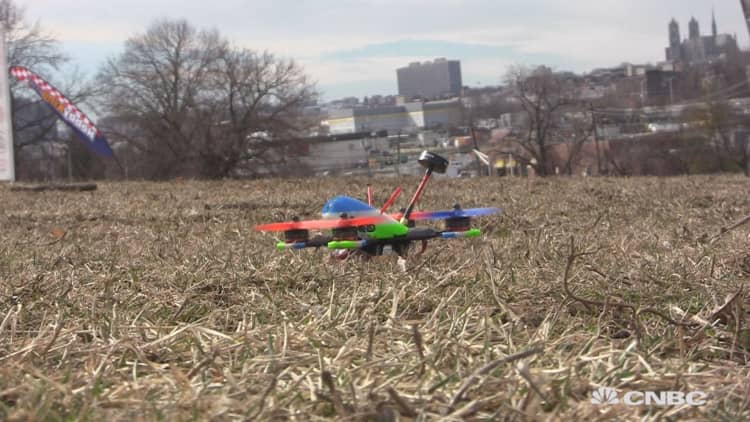
On a bright, breezy day in New Jersey, a sharp buzz — something like a cross between a mosquito and a dentist drill — pierced the air, made by a drone performing a hairpin turn.
Andy Shen, sporting chunky white goggles, tinkered with a handheld device nearby. He was indulging a passion that he's managed to turn into a successful business.
Shen flew an in-house drone design called the "Krieger," a zippy quad copter unit. Racing lets the 51-year-old entrepreneur meet his customers, get immediate feedback, and test designs and refinements.
Shen is a drone frame designer and a participant in an emerging sport that combines aviation, technology, tinkering and gaming. In a booming market for privately owned drones, he caters to a specific segment with a company called Shendrones, which produces custom frames for professional drone racers.
In a field defined by camera drones like the DJI Phantom—and at a time when unmanned aerial vehicles (UAVs) are delivering packages, taking pictures and undertaking clandestine government operations—drone racing remains a niche. However, the FAA expects the commercial drone market to explode from 1.9 million in unit sales last year to 4.3 million by 2020. In a 2016 report, NPD Group said commercial drone sales skyrocketed by more than 200 percent from 2015.
Such bullish forecasts encourage converts like Shen, who believes the future of the sector is intertwined with the growing emphasis on science, technology, engineering and mathematics in education.
"A lot of STEM programs are looking to incorporate drones," Shen told CNBC. "Physics, aerodynamics, electronics, programming, there's just so much to learn from it."
The difference between the great pilots and the OK pilots is that the great pilots will recover more often than not.Michael Tsengdrone racer
'Fatsharks' and flying contraptions
At first glance, drone racing doesn't look high-octane, or even high tech. Racing drones, even when competition ready, often look anything but: Their shells are a hodgepodge of exposed wiring, antennae and 3-D-printed plastic enclosures that appear barely durable. The frame serves as a mount for the rotors, engines and controllers, and sometimes sells with enclosures that boost aerodynamics and protection.
Last year, ESPN signed a deal with the International Drone Racing Association to broadcast drone races, seen as a big bet on a sport still in its infancy. It also presents an opportunity for upstarts like FloRotoRs and Shendrones, who sponsor pilots and provide frames, kits and support. Sponsored racers also help stress-test frames in a real world setting.
"I can't fly like those guys can," Shen said. "They're pushing it and giving me feedback that I couldn't get myself with the product."
At a recent event attended by CNBC, rows of participants sit in camp chairs, peering into futuristic "Fatsharks" — goggles that enhance video photography and drone racing. Only through the lens of these "first person view" devices does the sport's addictive quality become apparent.
FPVs allow the viewer to see the world through the "eye" of the drone itself, a modified security camera transmitting instantaneous video through a radio frequency. The speed and agility of quadcopters, a common four-propeller design, makes FPV racing less like being inside a cockpit and more like an out-of-body experience. The aircraft are surprisingly aerobatic: Some races are even designed with vertical gates that pilots must dive (or fall) through.
A plane — or a car for that matter — "would never make it through any of these courses," Shen said.
Budding interest has created an entire cottage industry around drone racing, including sponsors, specialists and experts. However, the environment remains collaborative, said Florent Arnoux, founder of rival frame maker FloRotoRs, who frequently works alongside Shen.
Arnoux, a Stamford, Connecticut-based mechanical engineer, lends Shen information about plastics and taps into Shen's experience sourcing carbon fiber. "We fuel each other with ideas," Arnoux told CNBC.
'I'm really good at this'
Shen's studio apartment and workshop in Manhattan has the ordered chaos of a tinkerer, littered with half-assembled drones and dismantled parts. All of the drones Shen uses get taken apart and re-used, he said.
The University of Chicago graduate studied painting before becoming a freelance photographer, where he began experimenting with aerial photography. He started dabbling with drones in 2012.
"I was a good photographer," Shen said, "but I wasn't a great photographer. I'm really good at this."
Shen grew an early reputation designing quirky drones he sold online. One had a hopper that shot Nerf foam discs, while another was made entirely out of bamboo and assembled using interlocking parts instead of screws. However, Shen discovered that quirky didn't always pay the rent.
"Just because someone [shows interest] doesn't mean they're actually going to buy it," he said as he brandished a drone that resembled a one-eyed grasshopper. The "Tweaker" eventually became one of Shen's best-sellers.
The simplicity and modularity of racing drones mean racers often build them on their own. Shendrones helps the community by blogging the frame design process step by step, including parameters, materials and failures.
Shen's designs begin with utility. "If you make things really functional, they start to look good," he said. He's also not all that concerned with competition, boasting of his combination of real-world experience and unique design.
For now, Shendrones gives its founder a sense of autonomy, creativity and income. While Shen hopes business will continue as interest in racing grows, he freely admits to having no solid business plan. "I've always done other things before, I've always landed on my feet," said Shen.
Drone pilot Michael Tseng echoed Shen's sentiment, applying it to real life.
"The difference between the great pilots and the OK pilots is that the great pilots will recover more often than not," he said, likening it to a racer "clipping a gate. When you hit something, you're not out."
Correction: Andy Shen is a drone designer. An earlier version mischaracterized his title. ESPN signed a deal with the International Drone Racing Association in April 2016. An earlier version misstated the timing.





